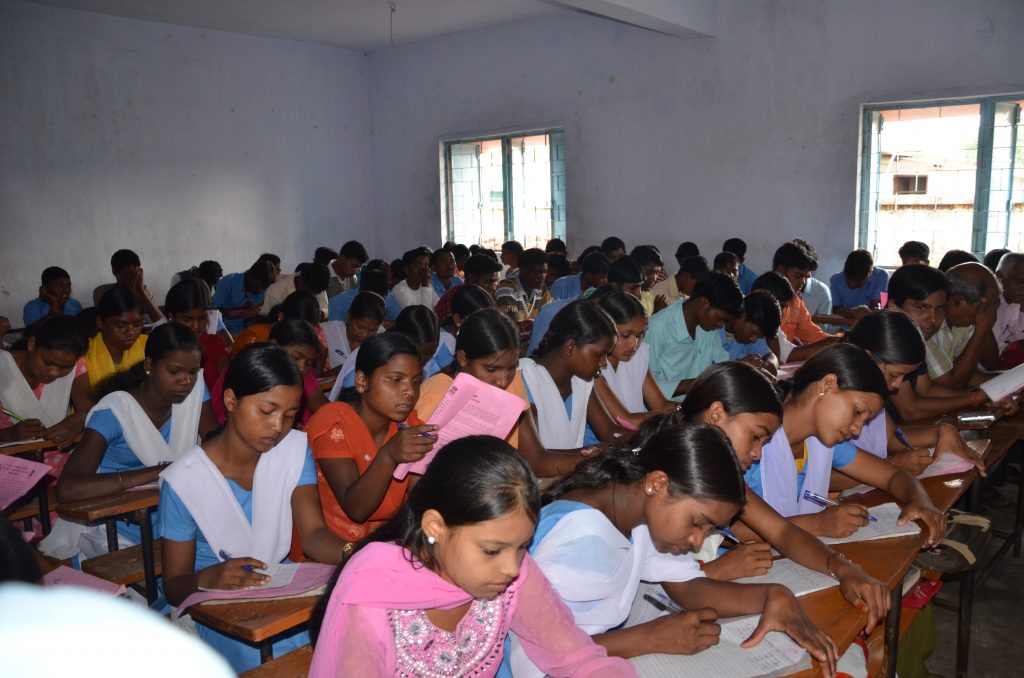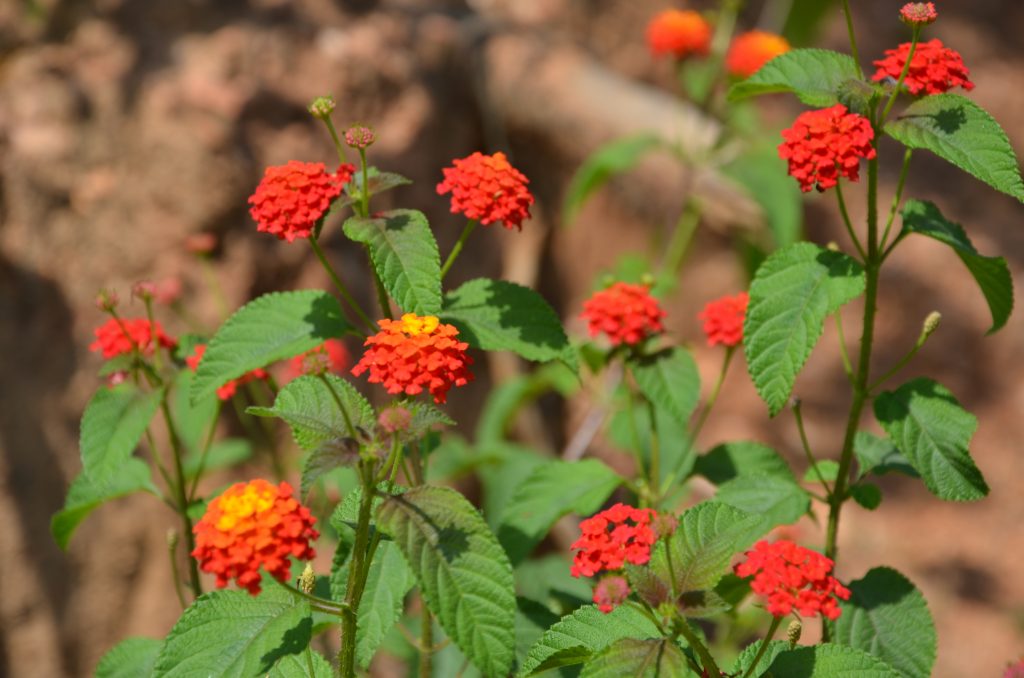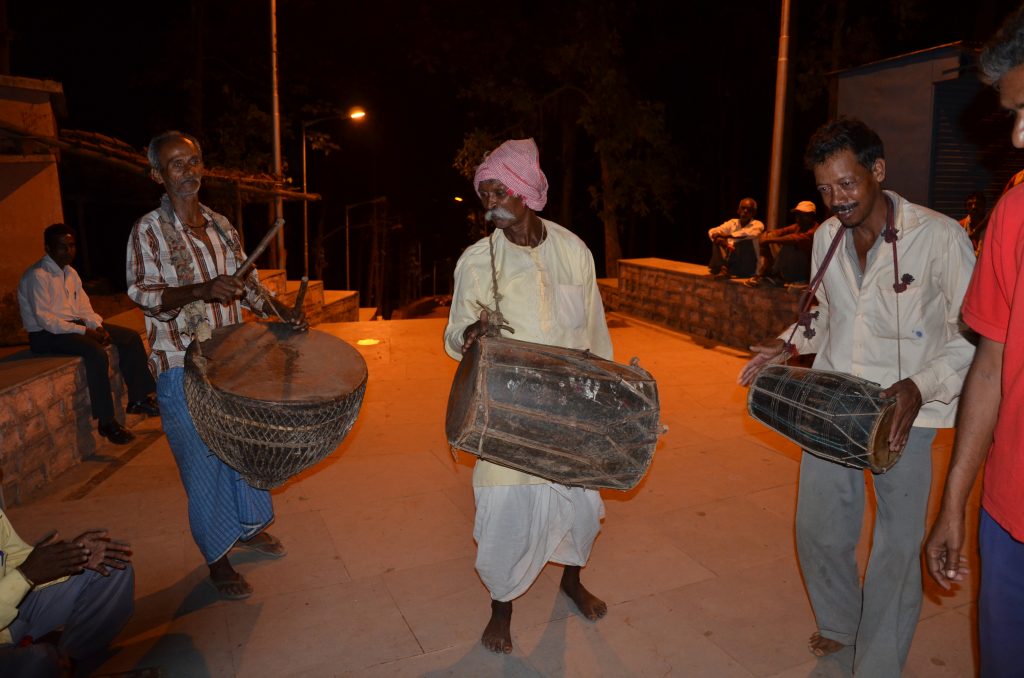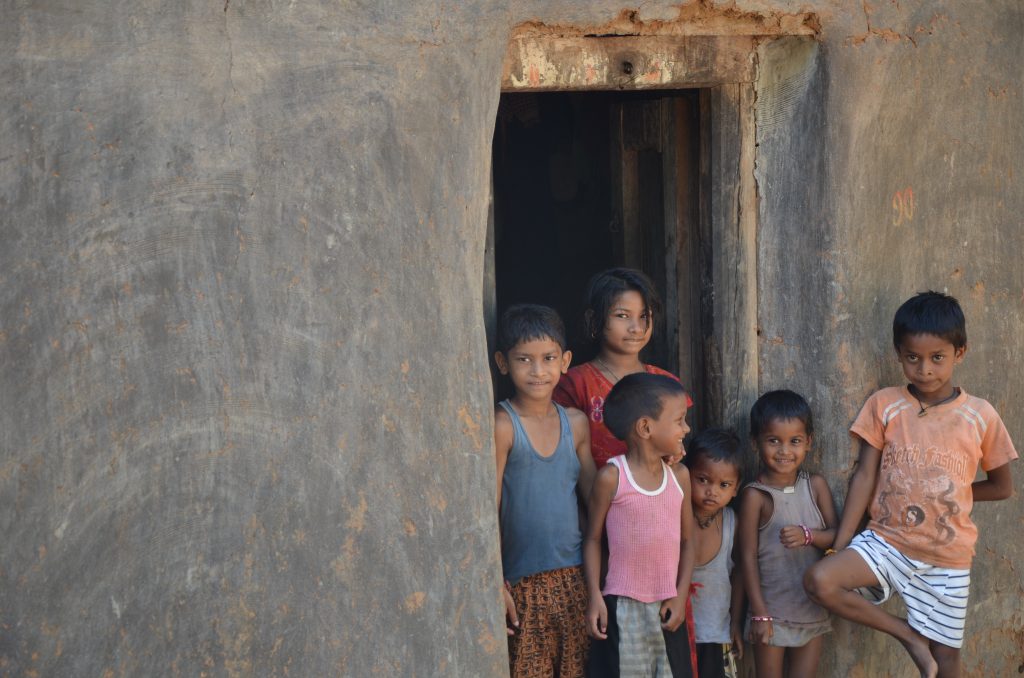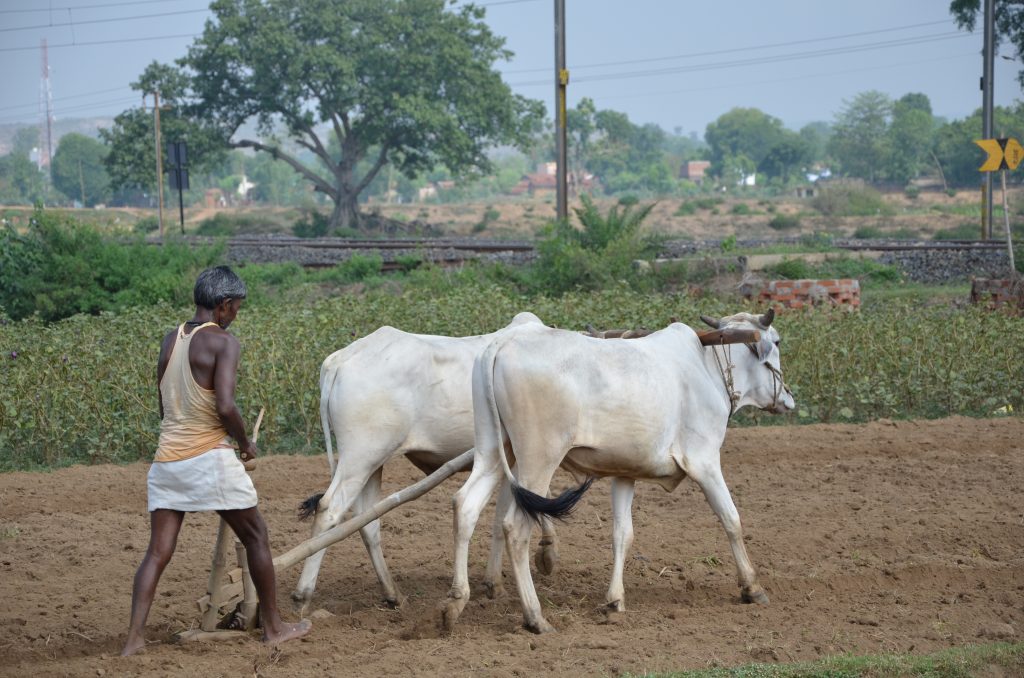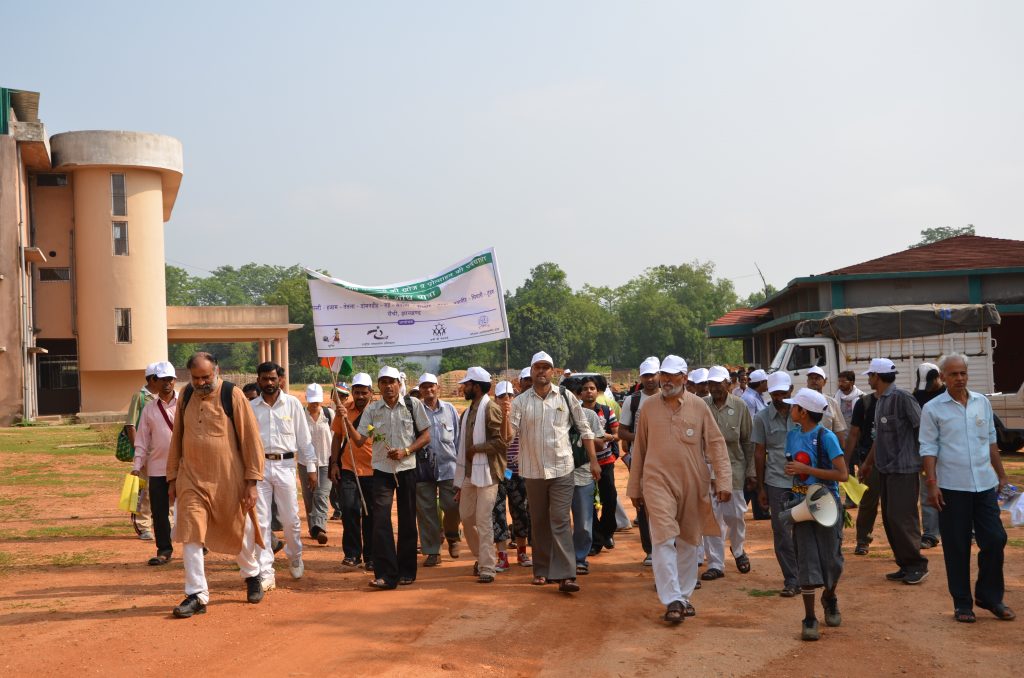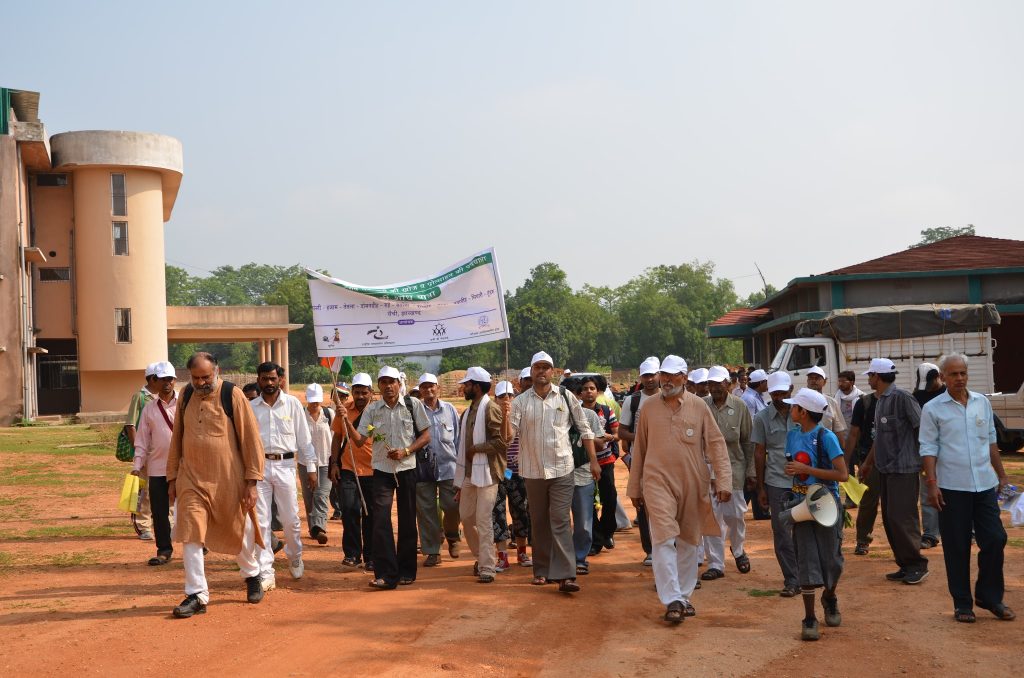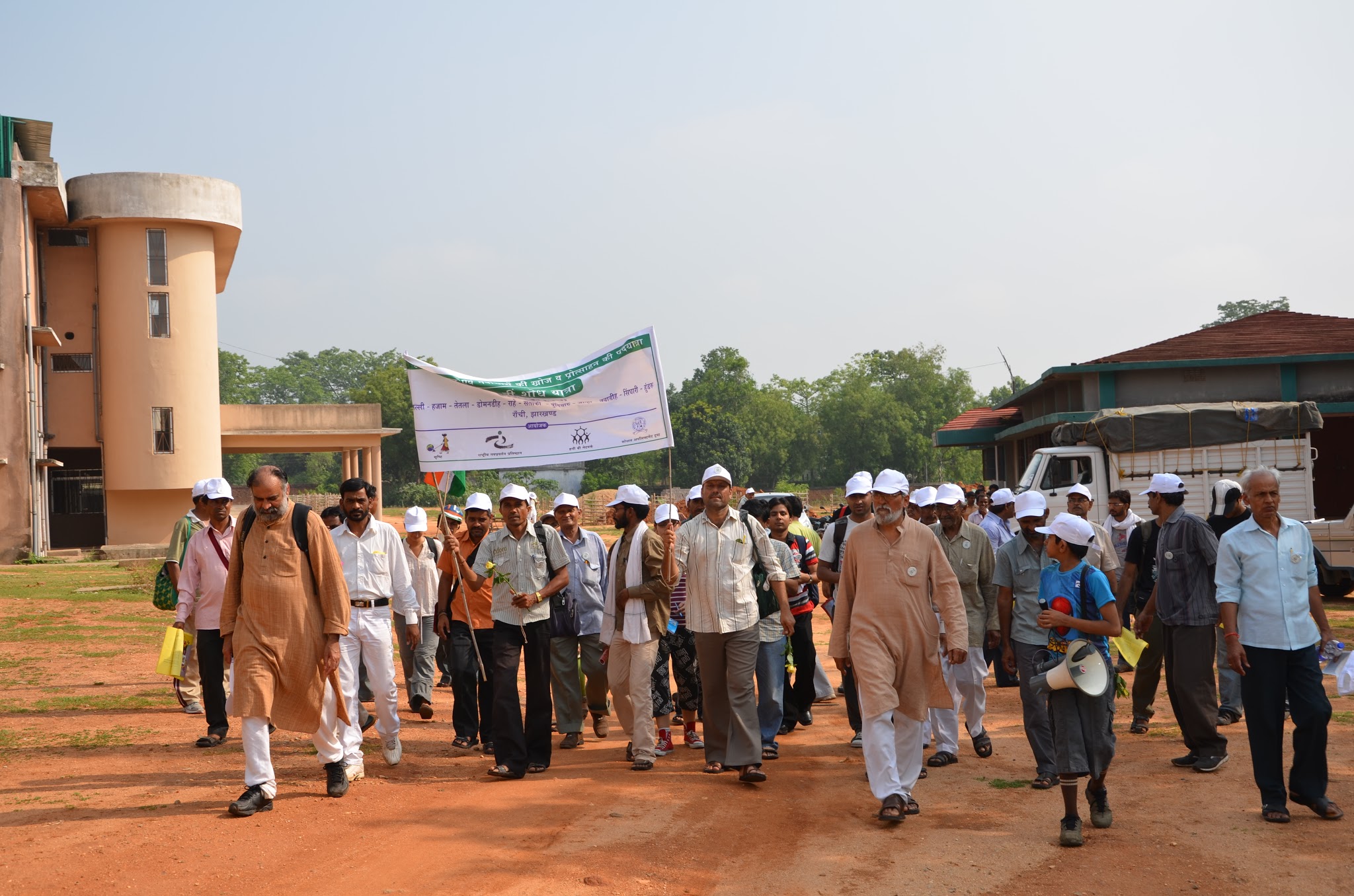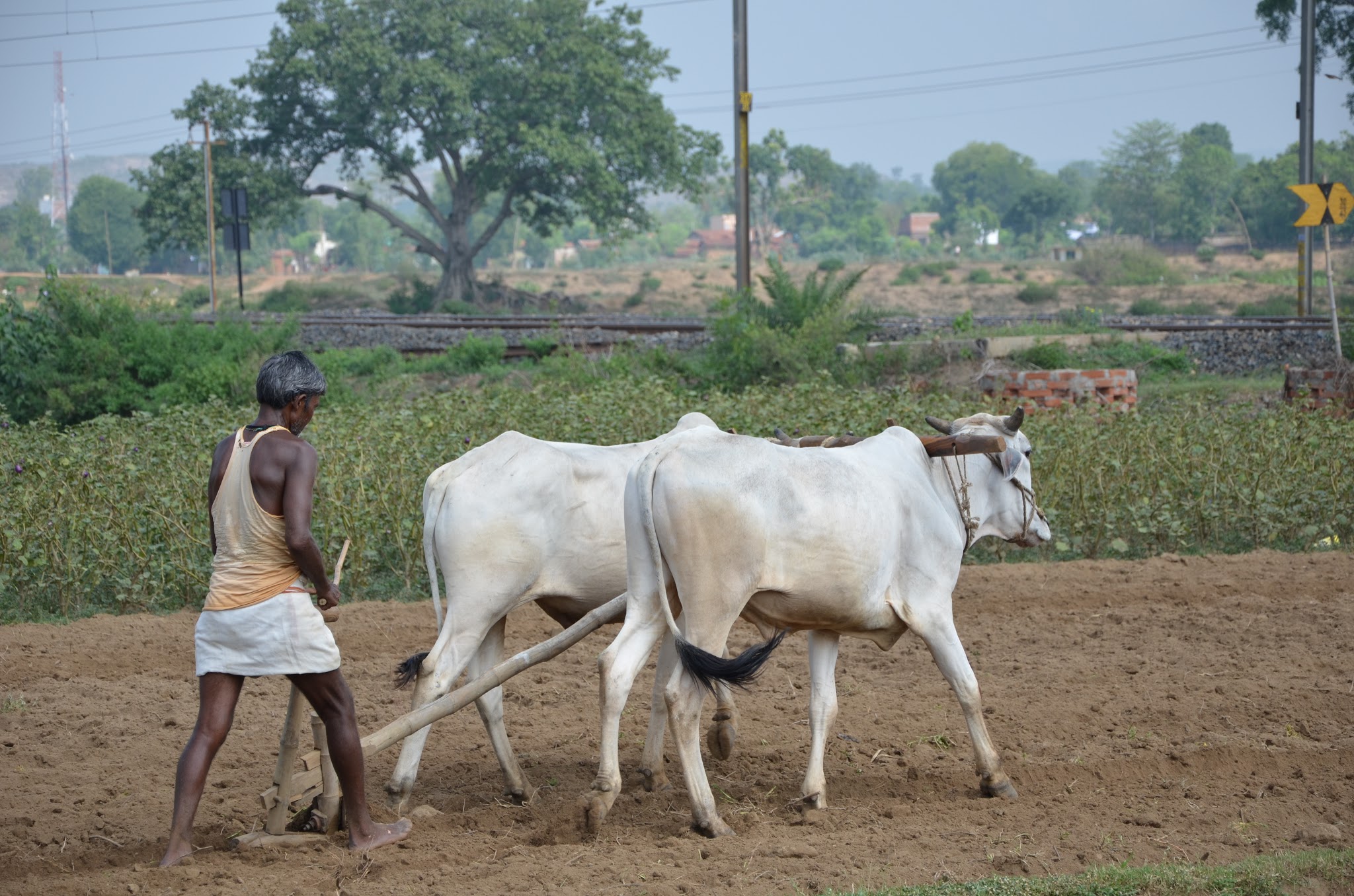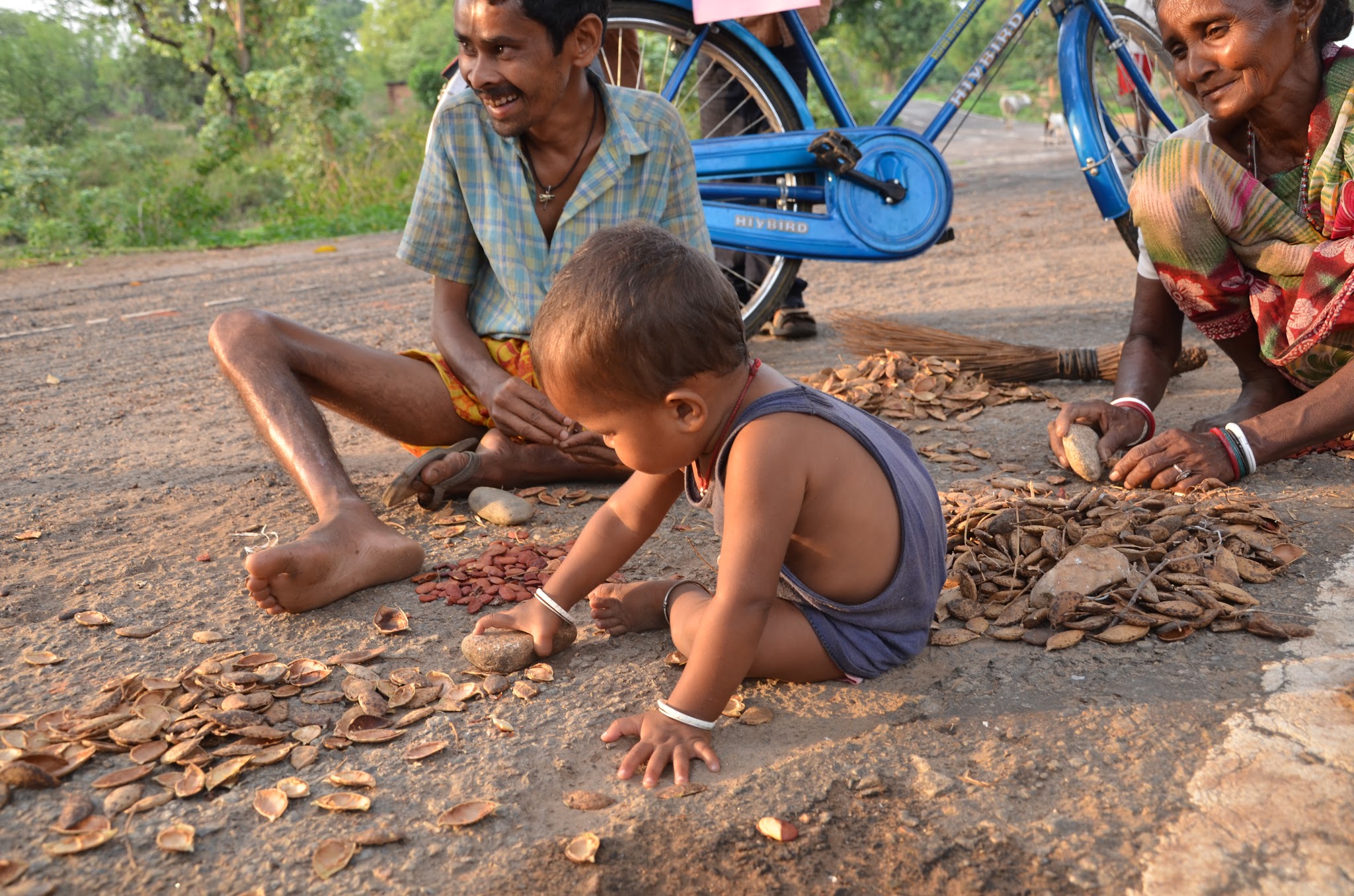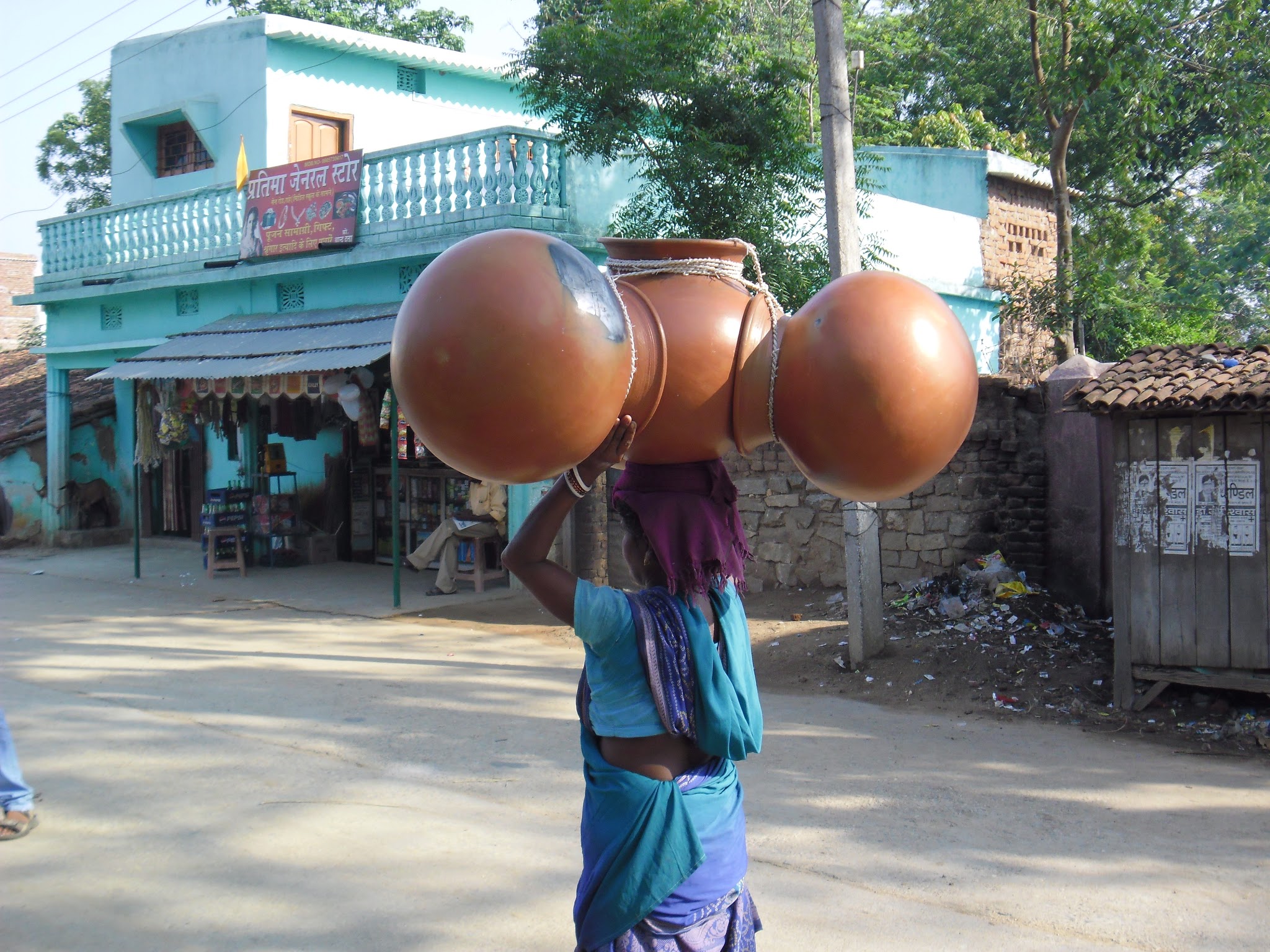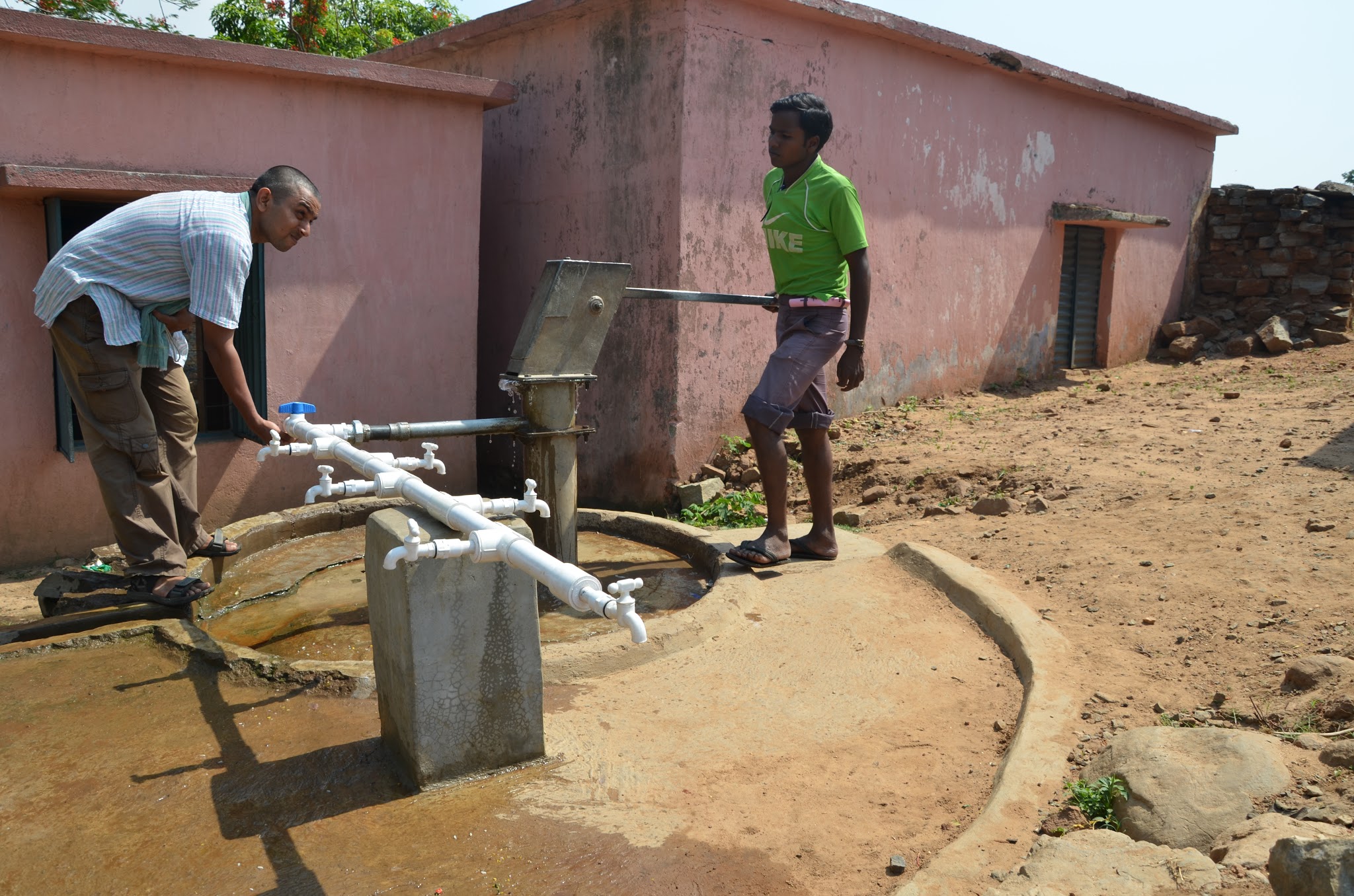Get Next Shodhyatra Update:
Phone:
079-27913293, 27912792
Email:
shodhyatra@sristi.org
27TH SHODHYATRA (KISAN BHAWAN TO HUNDRU, RANCHI, JHARKHAND)
28th May to 3rd June, 2011
Every year, in summer and winter, SRISTI organizes Shodh yatra along with NIF and other Honey Bee Network partners in different parts of the country. The purpose is to share what we have learned so far from local communities and learn what we have not. It is natural that every place will offer new insights about how people cope with different stresses and try to innovate or use traditional knowledge to solve every day problems faced in life. We try to harness, honour and horizontally link the local wisdom and creative spirit. There are two shodh yatras, which generally begin every time, one within each yatri, whose end we dont know, and another is the external one, of which the end date is known. The shodh yatras are guided by community spirit of solidarity, sharing of costs and living frugally so that we experience some of the difficulties that local communities have been living with for ages. Voluntary suffering (if there is some at all) is intentional so that we remain humble and open to learn from within, each other, nature and common people we meet during our walk.
The actual Shodh yatra began one day before when we reached Ranchi on 27th May night. There were three young innovators who impressed us with their amazing creativity. Mohammad Sajid Ansari, a student of class seven, had observed his mother, Rubaiah Khatoon cleaning rice every day. Generally, some rice gets broken while beating the paddy seeds in the manual husking device and some impurities and other materials also get mixed. Most of us have observed similar sights at our home. But, majority of us have learned to live with problems unsolved indefinitely. This is a crime, which our generation has committed almost uniformly in the context of numerous problems faced by poor rural women. Sajid was different. He did not live with the problem unsolved. He innovated an electrical machine, which separated full grains and broken grains along with other impurities etc., in just about Rs. 2000/-
Nowhere in the country, have we come across a small desktop machine for the purpose. His father, Kalim Ansari is a tailor and provides his services door to door through a mobile sewing machine mounted on a cart. Unfortunately, during the removal of encroachments in the Ranchi city, their house was demolished and they had to move to village Pirra, in Ratu block of Ranchi. Sajid joined the Shodh yatra during the last two days and showed his creative skills to children in the school and other villagers. He is also a very good Urdu poet and was recognized for his literary skills by the former Governor of Jharkhand. He was also given fee waiver. Let us hope that he will be mentored by Shodhyatris in future and his talent would get due recognition in future.
We also met two sisters viz., Garima, 12th class and Hina, 9th class who had fitted a battery operated fan on the top of a pen. Given the frequent power supply breakdown, fan would certainly comfort the writer. Next day, May 28th, we stayed at Kisan Bhavan, Silli and had a round of introductions. Participants from Uttrakhand, Haryana, Delhi, West Bengal, Gujarat, Jharkhand, Andhra Pradesh, Bihar, etc., shared their expectation from the Shodhyatra. There were foreign participants from UK and US, both students and faculty who wanted to explore the genius at grassroots. This Shodh Yatra was organized with the support of regional Honey Bee Network collaborator, Social Upliftment Trust, led by Rajeev Ranjan Pandey and members of the Literacy Mission.
All along the way, the Shodhyatris encountered a very deep articulation of curiosity to know, explore and dialogue. At several places on the way, the Shodhyatris were stopped and engaged about the local knowledge, livelihoods and culture. At some places, some of the villagers sang traditional songs to convey their vivaciousness. All along the way, there were many old trees as a witness of the local conservation ethic. But in the forests, there were hardly any old trees. Two consecutive years of drought and practically very little public works programme must have taken a toll of nature as well. When the trains full of people with head load of wood go to Ranchi, it is not surprising that trees are being chopped.
On the way to the next village, we met some labourers who enquired about the purpose of our walk. After some discussions, we gave a copy of Hindi version of Honey Bee newsletter viz., Soojh boojh to each one of them. They returned all the copies except one saying that we should use them to give it to others. The frugality was in action. They planned to share the same copy with others.
While going to Hajaam, there were not many fields, which had access to water. Even the drinking water well had low water table. While most wells had counterpoise arrangement for lifting water with a long pole tied with weight, some had a cycle rim used as a pulley with weight on one end of the rope and the bucket on the other. A small improvement, but useful still. In Hajaam, we met several midwives who had been practicing child delivery for many years. One of them viz. Tula Devi was extremely articulate and assertive. She gave many examples where the practices of the modern doctors, according to her, were not in the interest of the child or the mother. She mentioned particularly three aspects of child delivery where her suggestions were at variance from the practice in modern hospitals: [a] the umbilical cord should be cut after about ten minutes when it stops pulsating and the child is at peace, it avoids a shock, [b] the delivery should be done in a darker environment rather than a well-lit one because moving from the dark womb to a bright-lit room can shock and sometimes, as she said, infuse fear in the mind of the child, affect eye sight also and [c] the most convenient position for a pregnant mother is squatting or a reclining position instead of lying down as is the practice. She stressed that because of the delivery in lighted room, many urban kids had specs from the childhood. Tula devi also advised about when to bathe the mother and what to give for feeding; she was much against the conventional local practice of not feeding the mother for two days, and not milking the child within two hours on the first day.
Before entering Tetla, on the border of the fields, there were lots of Boswellia serrata Roxb. ex Colebr. (Salaya) trees with branches heavily pruned. The wood of these trees is harvested every year as a good quality fuel wood. The inner layer of the bark is supposed to be a good medicine for kidney trouble. Generally these trees are planted on the border of poorer soils since they affect the yield of the crops adversely. On the other end of the village, there was a small ritual ground where Vishvakarma was worshiped by local communities.
In most of the fields, which had access to water [there were very few], modern varieties of tomato, gourds, cucumber, etc., were grown. In Tetla, one could observe on the road side, only a few local varieties of tomato, chilly and some other leafy vegetables. The Shodhyatris stayed at the house of Deenanath Koiri. He was one of the most reputed bone setters of the region. In many cases, where institutional doctors had not been of great help, Deenanath would help the matters even without X-Ray, he could sense the problem and suggest solution. His approach to healing was quite at variance from the modern orthopedic doctors. He showed us a wooden bookshelf made by his father, which had a very unique acknowledgement. It was made by his father in 1963, the engraving on the wooden panel first had the name of the teacher from whom he had learnt and then his name.
The Shodhyatris witnessed the process of preparing medicine, primarily done by his wife and the bandaging by Deenanath on some of the patients. Before leaving, a question was asked as to why he did not transfer his skills to at least one of his four sons. He, of course, regretted that all the four sons had moved to Ranchi though one of his grandsons seemed quite keen learn.
But he was too young, hardly ten years of age. His response shocked the Shodhyatris. He said, “I was not sure that my younger son would have provided this service to the needy selflessly. He would have tried to make money out of it.†Before we were leaving, he said, “If you really want to pray for me, then pray that at least I could get one disciple before I die who will carry this healing tradition selflessly.†The ethics of knowledge transfer, concern for public good and objectivity in judging the suitability of his own ward could not have been communicated to us better.
After taking lunch at Kolma, Shodhyatris met extraordinary children at the High School at Domendih. We had a quiz to redesign the match stick, which we normally throw away after lighting a candle. Since it was made of wood, which is quite scarce, the challenge was to find a way of extending the life of each stick. Within a minute or two, we could get similar answers as were given by the students at IIMA or in China, USA, Malaysia where such an exercise was done earlier. Once the children were convinced that they could become inventors themselves, they were asked to imagine products or services which had either never been delivered or required considerable improvement. A large number of ideas came out, few of which were awarded on the spot.
The Shodhyatris stayed for the night at the primary school at Rahe. On May 30th, a local pooja was to end next morning, thus everybody had to absorb spiritual sounds in the air. We met Sunil Prajapati who had made several innovative devices including a Rs.100 candle filter, a chilli sprayer for self-protection by girls, and a substitute for gutka (tobacco containing powder), which doubles up as a mouth freshener as well. He was supported for selling ten of such filters so that he could assess the market and further support for scaling up this enterprise could be envisaged. Next day morning, we had a session with the students who had come for math tuition in the school where we also repeated the match stick experiment. The response of these kids was more subdued when compared to the senior students at Domendih.
While starting for Soso village, Shodhyatris saw an interesting arrangement of carrying four pitchers on the four sides of a central pitcher. After walking about ten km, just outside Soso village, we came across the first well being dug on the roadside. Five labourers had been hired to dig the well under NREGA. Most of these labourers had small farms in the neighbourhood. We asked one of them Dev Chahatar Mahato, as to why would he not dig the well on his own farm. Several reasons followed. There was need for employment, not enough resources to pay the other labourers, nobody had ever thought about digging well on ones own, etc. Then, a story was narrated, which the Shodhyatris had experienced in Karnataka Shodhyatra in 2004. Chand Hussain was a farm labourer in Hariharpura. About ten years ago, his daughter had gone to fetch water from a neighbours well. For some reason, neighbour did not like it and scolded the girl. When she came back crying, her parents were very upset. That day, Chand Hussain and his wife Ayesha Beewi resolved to dig a well on their half an acre plot. Every day when Chand Hussain would come back from work, he and his wife would work from 6 pm till midnight and dig the well. They had no rig or any major tool. With the help of spade, hammer, pick axe, they dug about 38 feet when they came across a hard rock. They could not afford dynamite, so they continued to break the stone. Even after reaching 70 feet, they did not get water. They went to a priest, did some prayer and finally after the struggle for a year, they found water. Though they were denied water themselves, they never denied it to their neighbours. They were felicitated in a Hindu temple.
When the labourer heard this story, he could not restrain himself any further. He decided that he will also dig a well without waiting for government support. There were many problems still to overcome. The plot he had was jointly owned by four brothers. Except him, everybody worked outside. Their consent would be necessary. But he was willing to take the chance. He promised to let us know as and when he would make some progress. When the Shodhyatris were leaving, he mentioned that nobody had ever kindled his faith in himself. Transition from a defiant ‘cant do to ‘can do reinforced the faith of Shodhyatris in their mission.
At Soso, two outstanding herbal healers were honoured for sharing their knowledge. One of them, Rameshwar Ahir, was upset that the certificate we gave did not authorize him to practice his healing services. It took some time to explain that without Validation, we could not even mention that his claims were valid. Even after validation, only the bodies authorized for the purpose could do so. In the recent past, IGNOU [Indira Gandhi National Open University] had taken steps to issue what they called as certificate of Prior Learning. Quality Council of India was taken on Board by IGNOU for developing certification standards. The incident brought into sharp focus the tension underlying our task of recognizing the herbal healers and other traditional knowledge holders for their contribution towards conservation of knowledge and resources without making any tangible difference in their life in the immediate future. The validation process, important as it is, takes long and there are no institutional arrangements to create a collegium of outstanding traditional knowledge experts to validate their claims empirically. Hopefully, IGNOU will take some steps in that regard. Shodhyatris moved for Jonha Fall via Kherbeda. The passage was along a seasonal river and then through a diverse forest. On the way, there was a viewpoint reportedly created by a large company under CSR with half the tiles broken and not well maintained. There was also a small temple where the local communities believed goddess Sitas footprints were found on a stone. The temple also was not looked after. After Shodhyatris reached Jonha Fall for night stay, a very interesting cultural interaction followed with local farmers and the catering staff at the facility. None of the staff received any salary though they were allowed to charge for the services they offered to the tourists. It was an entrepreneurial arrangement, which ensured good service but not necessarily the best maintenance. There was a musical performance in which local farmers narrated religious stories interspersed with stories of their own life. It was a unique style that was both entertaining and informative. Three of the workers at Jonha Fall viz., Birendarnath Mahato, Haridasnath Mahato and Surjan Lohra shared various strategies to deal with wildlife and also understand their behavior. While fighting a bear, the advice was that one should escape his face, and not let him spit on you, as he generally attacks the face and specifically the eyes. One should dive under and thus escape the attack. In the maize season, elephants normally attack the crop. There is a tradition of worshipping elephants around 15th June. They also look at the misty ring around the moon. Thinner the ring, longer it may take for rain to set in. The sounds of different birds indicated various changes in the weather. Koth paka, normally was heard at the onset of jack fruit season until the maturity of the fruits. Likewise, they had associated the sounds of different birds with the onset, duration of the rain or its cessation.
VILLAGE ELECTIONS AFTER 32 YEARS
Next morning, Shodhyatris walked through the forest and along a railway track to reach Jiddu village, situated on a small hillock having farmers, artisans and livestock keepers. Krishan Munda, the sarpanch of the village, was very upset that many of the families below poverty line [BPL] were enumerated as above poverty line [APL]. The panchayat elections were held after 32 years in Jharkhand. The local leadership largely comprised youth and women. They had aspirations to deliver but it seemed that the bureaucracy was not yet willing to let them do so. Initially, several village headmen had met informally and decided to not send any forms, which did not meet the local judgment of the gram sabha.
But when other headmen got coerced, he had to also fall in line. The survey of BPL families done by the administrative staff earlier before slection was not reportedly accurate. This is an issue, which is causing lot of discomfort at many levels in large number of panchayats. The lack of delegation of 29 different functions to the village panchayat so far was also a bone of contention. Without responsibility, it would be difficult to fix accountability. He was very clear that the forms he had sent were under coercion and did not reflect a just position.
ALL FOR A SWEET PAIN IN THE LEGS
Every village had a sacred grove called as sarna, bhasna [cremation ground], hargadhi [for various rituals] and jahar [where prayers were held and animals were sacrificed]. The ladies shared their rich repertoire about the local vegetables including koyna, kota, susni, teeta, munja, khapra, gulgula, etc. The susni vegetable made a person slightly sleepy and also introduced what the local ladies said, ‘a kind of sweet pain in the legs. They also cooked the tender leaves of bamboo and the vegetable called as phutkal . In addition, saroti and gundri were also cooked. The raw fruits of dambu were also consumed.
Valsa Munda shared a recipe for controlling jaundice and loose motion. The barks of seven trees were soaked in oil for three days and the filtrate was given in the early morning for making people healthy for rest of the year. These trees were hurra (Terminalia chebula), baheda (Terminalia bellirica), neem, mango, karanj (Pongamia pinnata), jamun (Syzygium cuminii), dhela (Alangium salvifolium), chironji (Buchanania lanzan).
TYING RAKHI TO SAVE TREES
After Jiddu, we stopped at Hedlabeda and interacted with the local community. Mahadev Mahato from Hazaribag shared his experience of conserving forest and enlivening the environment of school at several meetings. In his school, he had planted large number of trees and flowering plants to improve the environment for the children. We pleaded with the local communities and school teachers at every stop to plant flowers, make school environment better and try to put inspiring slogans [as witnessed in abundance during Anantnag Shodh yatra in J&K] on the walls. He had persuaded local communities in hundreds of villages in several districts to allocate at least ten per cent of the forest for conservation. He would announce a particular date in consultation with the local community on which date, everybody would gather in the designated forest, perform a small pooja and then tie a rakhi [a small red ribbon] to a tree each.
They would then make a commitment to protect that tree forever. They will meet every year on that date at that place to commemorate the event. The process has become very popular and can, infact, go a long way in conserving some parts of forest as sacred forest everywhere.
The night stay was at Jonha high school. Before reaching Jonha, we met an organic farmer Vijay Ranjan Prasad, a former journalist, who had planted many fruit crops and medicinal plants in his farm. While there was a controversy about how he acquired the farm from the tribals, he was doing several innovative experiments and sharing the seed materials of turmeric and other crops with local communities all around. He had developed a system of grafted guava cultivation at a distance of 4 x 4 in which he got about 10 kg fruit per plant per year. His reputation in terms of quality products certified by international agencies was reported to be good and the visit to the farm did convince shodh yatris about his authentic practices.
REFLECTIONS AND CREATIVE CHILDREN
In the night, a meeting of shodh yatris took place in which everybody reflected on their learnings so far and how their inner yatra was progressing. Next morning, the shodh yatris engaged the students into some creative thinking. Some of these interesting ideas were: [1] Why couldnt the plastic waste be melted and used for layering on the road [Rajesh Kumar Mahato was not aware that a Professor in Madurai and an entrepreneur in Bangalore had actually established experimentally that mixing ten per cent plastic waste in bitumen could save cost and improve the quality and life of road. He was on the edge. [2] Neha Kumari felt that a machine to cut vegetables was necessary while [3] Soni Kachchap thought about a masala grinding machine. [4] Manjay Prajapati and Manoj Rajwar took the cake for suggesting a remote control mechanical plough for the field. These were kids from 9th to 11th class coming from rural areas, mostly tribal and had limited exposure. But their imagination knew no constraints.
Such a remarkable diversity of ideas convinced everybody of the enormous potential that exists among the kids. One girl made an extremely sensitive point, which touched the heart of every Shodh yatri. She mentioned that her father after drinking scolded her mother and it became very difficult for her to study. She wanted a room to be created in the village where such children can study and also bring their younger siblings to study. This idea could really solve a major problem of dropout and poor performance of tribal kids. Later, the students also shared the recipes they had made of various local plants and a compendium of local plants and their uses. There was enormous interest among children and it is hoped that many more ideas would follow by August end for IGNITE competition.
FROM EXTREMISM TO HUMAN RIGHT PROTECTION
During the Shodh Yatra, we met, among others, former member of Maoist Coordination Committee [MCC] who had gone from CPI [M] to CPI [ML] to MCC in search of radical answers for the problems of social inequity and continued injustice. He had volunteered to help in Shodhyatra. He also shared his knowledge about herbal healing. During the days of fighting, they needed quick fix solutions for healing wounds and cuts. Tridax procumbens L (Sherfu) leaves apparently healed the cut very fast and stopped bleeding almost instantaneously. He had joined the mainstream without compromising with his commitment to non-violent but just social order.
There is a need to expand such space for more and more activists to lobby on behalf of the poor so that they get their due. We have to accept that in the absence such activists, the bureaucracy steeped as it is, in the history of exploitation, will not let justice be done. Even among the bureaucracy those who do wish justice to be done will find such activists very helpful and supportive of the cause of fair and just public order. There can be no better way of finding peaceful alternative for the current violent struggle going on in the region.
CURIOSITY ABOUT INTERNET ON HILLS
On the way, shodh yatris met women who had to fetch water from three to four km away and faced lot of difficulties in managing daily chores. There were also men who played cards on the roadside, as if indifferent to the travails faced by the women folk. The use of liquor was quite common and opposition to the same among women was also quite evident. This is a reform long overdue. At Singhari, the shodh yatris stayed in a high school on the top of a small hill. The experience here was remarkable in many respects. There was a student, Rahul Kumar Mahato, who had figured out which hill top had the best internet availability. After passing a competition, he was given a password for a website from where he could download questions in different subjects every day. He will submit the answer through mobile phone and get the response. Such a desire to learn and get feedback is rarely found even in cities.
Here is a tribal boy who has created rigorous benchmarks for his learning every day. His sister was equally keen to explore opportunities of other learning. When various innovations were shown to the children and others in the village through a cell phone based projector, there were many innovations that students wanted to implement or fabricate in their village.
Etwa Bedia was a social worker and had been trying to pursue various activities of community in development in this area. He lost his father in childhood, had to discontinue his studies and devoted himself for local development. In 1979, he tried to form an organization and began with prohibition and some other social reform. Although liquor was sold on the roadside, not too far from the village, but attempt was at least made. He has taken up many activities in water conservation. The payment under NRGEA has not been made for the last two and a half months. If the stone lining was not done, most of the wells would sink in and the walls will collapse. The entire labour would go waste. This was one of the most urgent concerns of the community.
TOWARDS THE END OR A BEGINNING?
Next day, the shodh yatris walked through the forest and the fallow fields towards Hundru. In this stretch, there were many fields, which were ready for sowing. Farmers in this region appeared to be more little more resourceful. The diversity in the forest was modest. On the way, shodh yatris saw a patch of forest having been conserved by the community with no lopping or chopping. The climb through the forest on the way to Hundru Fall was tough for some of the shodh yatris. At Hundru, shodh yatris interacted with the school children and also met head swami of Ramkrishna Mission along with some senior officials of the government, state head of Mahila Samakhya and a few other local community members. The children were provoked to come out with new ideas though the response remained a bit subdued. All the shodh yatris started reflections on their journey so far while departing for their homes. Some lost their train and thus got additional opportunity to see Ranchi and its neighbouring region. Some went back to one of the villages we had already visited to wait for the train next day. Some of us met the Chief Secretary along with Secretary, Agriculture, Secretary, Science and Technology and Director, State Council of Science and Technology. The discussions for over two hours were very meaningful and the feedback from the shodh yatra was treated with lot of attention and respect. On some of the issues, action was initiated right then. The ideas discussed were
- There was a tremendous desire to learn and share among local communities. During the previous 26 shodh yatras, such a desire was perhaps seen only in Jammu and Kashmir during Anantnag Shodh yatra. This means that a massive engagement can be launched about local knowledge and its valorization by formal institutions.
- About 45 different kinds of leafy vegetables (saags) were enumerated and offered to shodh yatris in various villages. Many of these saags reportedly had nutraceutical properties. Powder of these saags could be commercialized as soups base and also as ready to cook vegetable and thus add to the income of local communities. Care should be taken that distribution chain should not be aimed at urban areas only (as was the effort in Operation Flood) but also look at the rural distribution.
- While there were a lot of old trees on the roadside in almost all the villages, there were hardly any old tree in forests through which shodh yatris passed through. May be the idea of Mahadev Mahato of Hazaribag can be replicated here where he persuaded communities to tie rakhi to individual trees and thus protected them voluntarily.
- Chief Secretary (CS) advised Principal Secretary, Science and Technology to consider promotion of grassroots innovations under State Council of Science and Technology. He suggested giving advertisements in local news papers about IGNITE (childrens national competition of original ideas and innovations) and Biennial competition organized by NIF jointly or otherwise. Accordingly, a MoU between NIF and State Council of Science and Technology may be undertaken for the same (NIF has already received a mail from state science council and further action will be initiated in coming week itself). A State innovation Council may also be constituted or as CS suggested, combined with state science council.
- For making check dams a visit of selected villagers and/or engineers to Gujarat can be arranged to meet and see the check dams inspired by Premji bhai Patel. Similarly, few farmers and/or engineers can be sent to Gujarat for training for improvement of agricultural implements from innovators like Amrutbhai Agrawat, Mansukh bhai Jagani etc. Their travel expenditure may be borne by Jharkhand govt. NIF will help them in training and also provide few pieces at its cost for testing of implements in their fields at Jharkhand.
- NIF will do prior art search and will validate the potential technologies scouted during the shodh yatra. CS suggested that for the same District Innovation Funds can be utilized. An interaction between planning secretary and NIF may be facilitated so that we could actively use DIF to promote grassroots innovations in the state.
- A project for the starting a natural product laboratory has been already submitted to JHAMCO by SRISTI at the suggestion of then Development Commissioner and now, Secretary, Drinking Water and Sanitation. He has also expressed interest in such a laboratory. A natural product lab in the state will help a great deal in characterization of local biodiversity and creation of knowledge based market for the same.
- CS was also briefed about the techpedia.in initiative of SRISTI, which may be pursued with Director, Technical Education so that similar pooling of all projects by technical undergraduates and post graduates is done every year. These students could also be linked with MSME clusters so that the problems of small entrepreneurs and informal sector could be put on the table of students for their final year projects. A concrete follow up is still to be undertaken.
- Mohd Sajid Ansari, a young boy of class seven may get a national recognition for developing an extremely versatile machine developed for sorting broken rice, inert material from the full grains of rice. This will fetch better price for those who thrash and husk rice at home and also improve the quality of life for those who can afford such a small 2000 Rs machine. Unfortunately, his home was demolished during removal of encroachments in Ranchi and thus had to move with his family to a village in Ratu 15 km away. It will go a long way if he is rehabilitated and also supported for higher studies. He will bring a great credit to the state without any doubt.
Similarly, many more ideas may be explored for prototyping and value addition. The issues of APL and BPL (some inadvertent exclusion and thus the need for inclusion), absorbing the ex-Maoists in the mainstream (ensuring their occupation of human right watch space is not thwarted by local police officials and thus they become a legitimate grievance handler of local communities in tandem with gram sabhas), pending payments under NREGA scheme and its implications for wastage of semi-complete wells due to sinking of earth in the absence of stone pitching, making products based on local knowledge and commonly available plants were also discussed among other things. A hand pump based drinking supply innovation noticed in one of the villages was much appreciated by shodh yatris and the Officials alike and we may like to recognise the officer or teacher who first conceived it.
CS and his team were invited to Gujarat to see the potential innovations that can be used in Jharkhand.
SOME OF THE PRACTICES SHARED BY HEALERS :
Roots of Boerhavia diffusa L. (khapra Sag) and Achyranthes aspera L. (chirchiti) pounded together and juice is given to treat dysentery. (Chetanand Bediya, vill. Koynardih)
Roots of Cassia occidentalis L (Badka Chakora) and Butea monosperma (Lamk.) Taub.
(Paras) pounded and juice is given for treating stomachache and for anthelmintic.
(Chetanand Bediya, vill. Koynardih, Lal Mohan Kushwaha, Vill Titala)
Root paste of Cissampelos pareira L. (Pittu jadi) is given along with jagerry for stomachache. (Chetanand Bediya, vill. Koynardih)
Fruit Juice of Aegle marmelos (L.) Correa (Bel) is given to treat constipation. (Lal Mohan Kushwaha, Vill Titala)
Leaves of Scoparia dulcis L. (Tan dhaniya) crushed and juice is given with sugar candy to treat jaundice. (Lal Mohan Kushwaha, Vill Titala)
Leaves decoction of Moringa oleifera Lam. (Munga) is given to treat blood pressure (Community Knowledge)
Roots of Achyranthes aspera L. (chirchidi) pounded and powder is mixed in lukewarm sarson oil and applied on forehead for treating migraine. (Arun Kumar Koiri, Vill Titala)
FLICKR GALLERY
